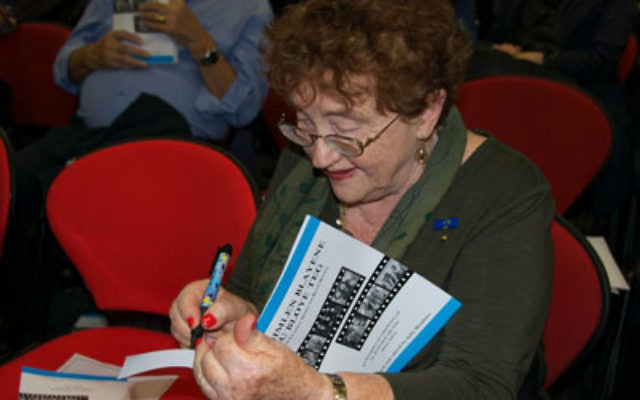Memories of Carlton shtetl
WHEN book editor Julie Meadows became involved in the “Write Your Story” program in 1998 to help members of the Melbourne Jewish community publish their life stories, she always wanted to produce an anthology of stories of European migrants who settled in Carlton.
In 2011 Meadows completed A Shtetl in Ek Velt, which contained the stories of 54 people who settled in Carlton between 1925 and 1945, reflecting their diverse religious, political, community and cultural affiliations.
At the weekend the companion book, Fun Himlen Blayene Tsu Bloye Teg (From Leaden Skies to Blue Days) featuring 45 stories of migrants who came on the “second aliyah” from 1945-75 was launched in Melbourne.
A product of Monash University’s Australian Centre of Jewish Civilisation’s Yiddish Melbourne project, the two books cover the full period of Carlton’s Jewish history.
“Carlton was like a protective time bubble, a life raft for people coming from Europe,” explains Meadows, who spent the past two years compiling and editing the book.
“For 40 years it was a thriving Jewish community, but by the mid-1970s few were left there.”
A Shtetl in Ek Velt provided a record of Jewish Carlton in its golden era, written by the people who grew up there including Bernard Rechter, Dulcie Kanatopsky, Harry Pose and Leon Mann.
Fun Himlen Blayene Tsu Bloye Teg continues the theme with memories by contributors including Nathan Werdiger, Adele Meren and Paul Grinwald.
Meadows says that the second wave of Jewish migrants who settled in Carlton after World War II mostly spoke Yiddish.
“These are their stories of survival in diverse and extraordinary circumstances. They are a poignant testimony to the human capacity to rise from the ashes to build meaningful, even joyful lives,” she writes in the foreword to Fun Himlen Blayene Tsu Bloye Teg.
“The newcomers more than doubled the Jewish population of the shtetl in ek velt and despite the trauma they had endured, helped shape the vibrant social and cultural life of Yiddish Carlton.”
She added: “The newcomers, however poor or traumatised, did not come empty-handed. Along with their burden of painful memory, they brought hope, energy and the knowledge of a thousand years of Jewish life and culture; even their wry irrepressible humour.
“They energised us, became our schoolmates and our shopkeepers; our teachers, musicians and actors; in time, our marriage partners, community benefactors and professional colleagues. Apart from the Yiddish language we all spoke, everybody barracked for Carlton.
“Yiddish Carlton was a historic necessity that lasted more than 40 years. It served its purpose and when people were no longer newcomers, they moved away. We need not mourn its passing, but neither should we forget it.”
When Meadows started work on the second book more than two years ago, she had no problem with getting sufficient contributors.
“I made a list to start off and had more than 20 names to approach,” she tells The AJN.
“A few people rang me and said they had heard on the Jewish grapevine that I was preparing a new book and asked if I would consider their stories.”
Having spent her childhood in Carlton – she was two when her Polish family settled there in 1937 and a teenager when they left in 1948 – she made many friends.
“At the time people walked around the streets and everyone knew everyone else,” she says.
“I grew up hearing the stories of people’s lives. I remember Manny Shadur in Form 2 holding hands with a girl saying this was the person he would marry, which he did. I had that story in my head all that time. Fifty years later I rang up Manny and said I wanted his story for the book.”
Meadows says she did not want the stories to dwell on the Holocaust.
“It was a much harder book to work on because I wanted to focus on Carlton rather than the Holocaust, but I found that I had to give people space to write about how the Holocaust affected them.”
Meadows, a former teacher who specialised in teaching English to new migrants, became the facilitator of the Makor Jewish Community Library’s “Write Your Story” program in 1998.
The program began with 10 weeks of government funding to help elderly Jews record their histories for their children and grandchildren. An advertisement in The AJN led to a strong response and within a week Meadows realised the importance of the project. She continued working on it for 11 years and by the time she left more than 100 books had been published, including anthologies of shorter stories. She was also honoured with a Medal of an Order of Australia in 2006 for her work on the program.
“I learnt on the job – it was a bit like doing lessons,” she says. “It would not have succeeded if there had not been an enormous number of people who wanted to take part in it.”
The “Write Your Story” program continues today by Makor Publishing based at the Lamm Jewish Library of Australia.
“When I was doing the ‘Write Your Story’ program at Makor, I always thought that a book on Carlton was always going to be my last book, my swansong,” says Meadows.
“I feel very privileged to have written about the people of Carlton.”
Asked if any more books are being planned, she says determinedly: “The Carlton series is finished. The next project I would like to do is about non-Jews who saved Jews during the war. They were people in the worst of times in the most dangerous of places who saved Jews with courage and generosity.”
Fun Himlen Blayene Tsu Bloye Teg (From Leaden Skies to Blue Days) is published by the Australian Centre of Jewish Civilisation. $35 (rrp). To purchase copies, buy online or email Julie Meadows.
REPORT by Danny Gocs
PHOTO of Julie Meadows at the book launch.


comments